US feed grain supplies for 2010/11 are decreased this month with lower forecast corn and sorghum production, reflecting lower yields based on September 1 conditions. Corn feed and residual use is decreased with the larger crop, but exports are increased because of rising world demand for coarse grains. Global coarse grain supplies for 2010/11 are projected down, with reduced foreign and US production. With lower feed grain production, 2010/11 prices for corn, sorghum, and barley are projected higher.
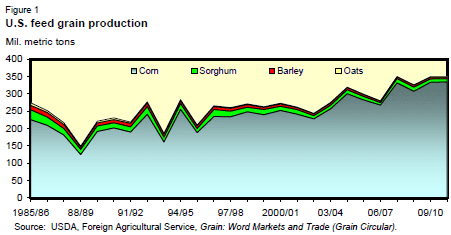
Feed Grain Supply and Use Down
US feed grain production in 2010/11 is forecast at 349.1 million metric tons, down 5.4 million from a month ago and up slightly from 2009/10. Corn and sorghum production are both down from last month. Forecast beginning stocks are down 900,000 tons from last month and down 7.3 million from last year. Feed grain supplies in 2010/11 are forecast at 390.7 million tons, down 6.5 million from last month due to lower carryin for corn and decreased yield forecasts for corn and sorghum. Feed grain supplies are down 7.6 million tons from last year.
Total feed grain use in 2010/11 is projected down 1.3 million tons this month to 358.7 million. Total use is up slightly from 2009/10. Lower feed and residual use is partially offset by higher exports for both corn and sorghum. Feed grain use in food, seed, and industrial (FSI) use remains unchanged for 2010/11.
For 2009/10, feed grain use for FSI is raised 900,000 tons this month due to increased corn use for ethanol production. Exports are also raised slightly to 54.7 million this month,reflecting increasing shipments to date of corn, partially offset by lower sorghumexports. This lowers projected ending stocks to 39.7 million tons for 2009/10.
Feed Use
When converted to a September-August marketing year, feed and residual use for the four feed grains plus wheat in 2010/11 is projected to total 145.1 million tons, down 2.9 million from last month and down 3 per cent from the 2009/10 forecast of 149.7 million. Corn is estimated to account for 92 per cent of the feed and residual use in 2010/11, down from 94 per cent in 2009/10.
The projected index of grain-consuming animal units (GCAU) for 2010/11 is expected to slightly increase from the 2009/10 forecast of 91.5 million units. The grain used per GCAU in 2010/11 is expected to be 1.58 tons, down from 1.64 tons in 2009/10. In the index components, GCAUs are increased for dairy and beef but decreased for poultry from last month.
Milk producers continue to add cows to the herd, and inventories are forecast to increase into mid-2011; however, according to USDA’s 18 August Milk Production report, current inventories of milk cows still remain lower than those of last year. With increased milk production in 2011, feed use by the dairy industry is expected to be stronger.
The decrease in beef production is attributed, according to USDA’s 20 August Cattle on Feed report, to lower placements of cattle into feedlots and reduced cattle marketings. In addition, higher feed prices are encouraging cattle producers to keep cattle on forage longer, thus reducing feed needs for the cattle on feed relative to last month.
USDA’s Quarterly Hogs and Pigs report will be released on 24 September and will provide an indication of sow farrowing intentions into early 2011. Higher feed prices are expected to slow pork production gains and reduce feed use.
USDA’s Broiler Hatchery report on 8 September indicated that broiler-type eggs sets and chicks placed have been increasing. Cumulative placements of broiler flock are up 1 per cent from last year. However, with a shorter production cycle than red meats, broiler production is expected to respond more quickly to the higher grain prices and thus more quickly reduce feed needs. Inventory of egg-type chicks hatched that will produce table or market-type eggs has increased 5 per cent from last year, based on USDA’s 23 August Chickens and Eggs report. However, egg production in 2011 is projected to be unchanged from last month.
The lower feed prices in early 2010 have encouraged turkey producers to expand output for 2011 after reducing production in both 2009 and 2010. The increase in feed prices for 2011 is expected to temper production gains. Thus, feed use by the industry may be reduced slightly.
Corn Yield Cut, Record Crop Forecast
Corn production in 2010 is forecast at 13.160 billion bushels, down 205 million from last month but still 50 million bushels above 2009. Based on 1 September conditions, the average corn yield is forecast at 162.5 bushels per acre, compared with 165.0 bushels per acre last month and the estimated yield of 164.7 bushels per acre in 2009.
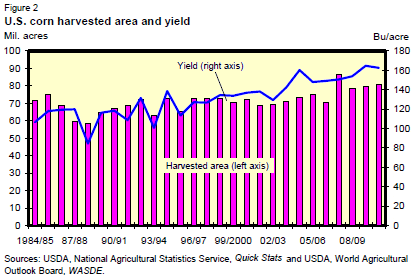
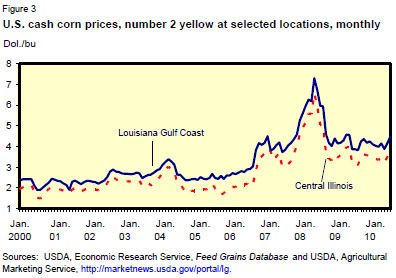
The 1 September corn objective yield data indicate the second highest number of ears per acre on record for the combined 10 objective yield States (Illinois, Indiana, Iowa, Kansas, Minnesota, Missouri, Nebraska, Ohio, South Dakota, and Wisconsin), only behind the record year of 2009. Record-high ear counts are forecast in Iowa, Missouri, Ohio, and Wisconsin.
Beginning stocks were lowered 40 million bushels this month to 1.386 billion. Forecast 2010/11 corn use was decreased 50 million bushels from last month to 13.440 billion, up 35 million from expected use in 2009/10. Exports were increased 50 million bushels to 2.100 billion as a result of reduced foreign supplies and increased global demand for feed grains. Feed and residual use of corn was lowered 100 million bushels to 5.250 billion because of lower supplies and higher prices. FSI use of corn remains unchanged at 6.090 billion bushels for 2010/11.
Projected corn ending stocks for 2009/10 are lowered 40 million bushels from last month to 1.386 billion. FSI use is raised 35 million bushels to 5.900 billion. This increase is in corn used for ethanol, based on record July and August production of gasoline blends with ethanol as reported by the Energy Information Administration.
Reflecting decreased supplies and tighter ending stocks, the forecast corn price for 2010/11 is raised 70 cents on the high end of the range and 50 cents on the low end of the range to $4.00-$4.80 per bushel. The 2009/10 season-average price received by farmers is expected to be $3.55 per bushel.
Sorghum Production Trimmed
Sorghum production is forecast at 376 million bushels for 2010/11, down 7 million bushels this month. Sorghum plantings and area to be harvested for grain for 2010/11 are unchanged this month but are down from last year. Based on September 1 conditions, sorghum yield is decreased 1.4 bushels per acre this month to 72.7 bushels per acre. In Kansas, the top producing State, producers are expecting a yield of 80 bushels per acre, down 2 bushels from last month and 8 bushels below the 2009 record yield. Producers in Texas, the second largest sorghum-producing State, expect the crop to yield 69 bushels per acre, down 1 bushel from last month but up 21 bushels from last year.
The decrease in production more than offsets the increase in beginning stocks, which are raised 3 million bushels to 31 million. Sorghum use for 2010/11 remains unchanged this month as decreased feed and residual use is offset by an increase in exports. Sorghum exports are forecast at 160 million bushels as global feed grain demand strengthens in 2010/11. Ending stocks for 2010/11 are projected at 37 million bushels, down 4 million from last month, reflecting changes in supplies.
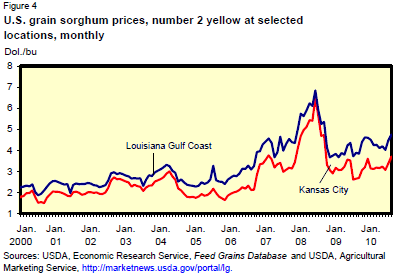
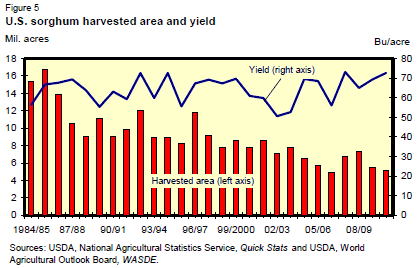
In 2009/10, US sorghum exports are lowered 3 million bushels this month to 167 million based on trade data to date. This results in a 3-million-bushel increase in ending stocks to 31 million bushels.
For 2010/11, the projected sorghum farm price was raised 50 cents on the low end of the range and 60 cents on the high end of the range to $3.70-$4.40 per bushel, as tighter corn supplies strengthen feed grain prices. The season-average price for 2009/10 is expected at $3.20 per bushel.
Barley Unchanged, Oats Imports Down
Barley and oats production were not revised in the September Crop Production report. Any production revisions will be reported in the Small Grains 2010 Summary to be released 30 September 2010. No changes are made this month in barley supply and use. For oats, imports were lowered 10 million bushels to 80 million for the 2010/11 marketing year due to smaller oats production in Canada. This import reduction lowers total supply and ending stocks by 10 million bushels.
For the 2009/10 marketing year, season-average prices for barley and oats remain unchanged. The 2010/11 projected barley price was raised 15 cents on each end of the forecast range to $3.70-$4.30 per bushel. The 2010/11 projected oats price was lowered 5 cents on the high end of the range and raised 5 cents on the low end of the range to $2.20-$2.70 per bushel. Stronger corn prices for 2010/11 are expected to support other feed grain prices; however, a substantial portion of the 2010/11 oat crop has already been marketed at prices well below current levels.
World Coarse Grain Production Prospects Down 10 Million Tons
Global coarse grain production in 2010/11 is projected to be 1,097.7 million tons, down 10.3 million this month. While the largest decline is in the United States, foreign production is down 4.9 million tons, almost as much as in the United .States. The largest reductions in foreign production prospects are for the EU, down 3.5 million tons, and for Russia, reduced 1.2 million.
Foreign corn production prospects are down 0.3 million tons this month to 491.8 million. EU corn production prospects are reduced 1.2 million tons to 54.7 million. France and Germany forecast area and yields are lower, while Italy, Austria, Spain, and Greece face reduced yield prospects. These reductions more than offset improved prospects in Romania and some small producing countries. There is also a small reduction in corn production prospects this month for North Korea as excessive rains have trimmed both area and yield prospects. These declines are partly offset by increased prospects for Canada and Mexico, each up 0.5 million tons this month due to improved yields. In Canada, production prospects in Ontario are good as most areas have enjoyed favorable temperatures and precipitation. In Mexico, some areas along the Pacific coast have had flooding, but rains have been generally good and water supplies in reservoirs have been favorable for irrigation. There was also a significant revision for Brazil’s 2009/10 corn crop, up 1.8 million tons to a record 56.1 million as the safrina (second, dry-season) crop was bigger than expected.
Foreign barley production is forecast down 2.0 million tons this month to 121.9 million. The largest drop is in Russia, down 1.0 million tons to 9.0 million, as harvest reports indicate that the severe drought has cut both area and yields. In the EU, barley production is reduced 0.6 million tons to 54.2 million, as spring and summer dryness followed by excessive rains during harvest in Germany and Finland trimmed yields. Excessive rains also cut yield prospects in Belarus, reducing production 0.3 million tons to 1.6 million. Morocco, also with a much wetter-than-normal growing season, reported reduced barley yields, cutting production 0.2 million tons to 2.6 million. Statistics Canada reported reduced barley area, but more than offset that with improved yield prospects, increasing barley production prospects 0.1 million tons to 8.5 million.

World sorghum production prospects are down slightly due to the US reduction. Foreign production prospects are virtually unchanged at 54.5 million tons, with a small reduction in France lost in the rounding.
Foreign oats production is reduced 0.9 million tons this month to 20.4 million due to reductions for the EU, Canada, and Belarus. The EU is cut 0.4 million tons to 7.7 million mostly due to reduced yields in Finland and Germany. Canada reported sharply reduced area due to excessive rains during planting, cutting production prospects 0.4 million tons to 2.4 million. Belarus reported lower yields, trimming production 0.1 million tons to 0.7 million.
Foreign rye production is down 1.0 million tons this month to 12.6 million. The EU is reduced 0.8 million tons to 7.7 million, mostly due to reduced area and yield for Germany. Belarus rye is cut 0.2 million tons to 1.2 million due to lower yields. EU mixed grain production prospects are reduced 0.4 million tons this month to 14.7 million, mostly due to production problems in Germany. Russia’s millet yield is cut in half this month, reducing production prospects 0.2 million tons to 0.2 million.
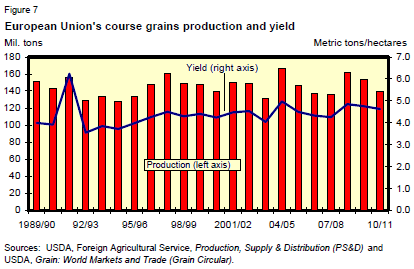
Increased Beginning Stocks of Coarse Grain For 2010/11
Global coarse grain beginning stocks for 2010/11 are increased 1.5 million tons this month to 189.4 million. Much of the increase is for Brazil, with increased 2009/10 corn production boosting coarse grain stocks 1.3 million tons to 12.9 million. Other increases of note include China, up 0.3 million tons due to increased 2009/10 corn imports; Australia, up 0.3 million because of reduced exports and feed use of sorghum estimated for 2009/10; Canada, up 0.3 million based on the stocks report by Statistics Canada; and Ukraine, up 0.2 million due to lower corn exports estimated for 2009/10. These increases more than offset the decline for the United States and a 0.2-million-ton reduction for Argentina caused by increased sorghum exports for 2009/10.
Global Coarse Grain Use Decline Mostly in the United States
World coarse grain use is down 3.5 million tons this month to 1,120.3 million. However, most of the change is in the United States, with foreign use reduced 0.6 million tons to 818.9 million. Ukraine’s expected domestic use of corn in 2010/11 is reduced 0.5 million tons this month due to strong demand for exports. Belarus coarse grain use is cut 0.5 million tons because of lower production. Japan is trimmed 0.2 million tons due to animal disease problems. However, feed use of coarse grain in the EU is up 0.9 million tons this month because of reduced wheat production. Mexico’s corn feed use is boosted 0.3 million tons, with increased corn production. The increase in local marketing year world imports by 0.9 million tons more than the increase in global local marketing year exports cuts world disappearance by 0.9 million tons.
Drop in Projected World Stocks Mostly in the United States
Global coarse grain ending stocks in 2010/11 are projected down 5.3 million tons this month to 166.8 million. Foreign forecast stocks are reduced 0.1 million tons to 134.7 million, as increases and decreases mostly offset. EU coarse grain stocks are reduced 1.4 million tons this month and Belarus is down 0.3 million, both due to reduced production. Morocco is reduced 0.2 million tons for the same reason. Argentina’s ending stocks are reduced 0.2 million tons due to lower beginning stocks of sorghum. Brazil’s 2010/11 ending stocks are up 1.3 million tons this month because of increased 2009/10 corn production. China and Australia have higher projected 2010/11 coarse grain ending stocks, each up 0.3 million tons this month due to increased beginning stocks. Mexico’s ending stocks are up 0.2 million tons due to increased corn production. Changes for other countries are smaller.
World Corn Trade and US Exports Boosted This Month
Global corn trade forecast for 2010/11 (October-September) is increased 2.0 million tons this month to 93.4 million. The largest increase in projected imports is for the EU, up 2.0 million tons to 5.0 million. With reduced production of corn and other grains, the EU is expected to turn to additional corn imports, especially as internal prices result in a zero import duty. Russia’s corn imports are projected 0.7 million tons higher this month at 1.0 million to support meat production, as drought has reduced domestic grain production. These increases are partly offset by reduced corn import prospects for Canada, down 0.3 million tons to 2.2 million, due to increased domestic production; and for Japan, down 0.2 million tons to 16.1 million because animal disease problems are expected to trim feeding.
EU corn exports are projected at half the previous month’s forecast, down 0.5 million tons this month as tight grain supplies and strong internal prices are expected to discourage exports. Strong import demand and attractive prices for exports are expected to boost corn shipments by Brazil and Ukraine 0.5 million tons each. However, with strong early corn export sales, US 2010/11 corn exports are boosted 1.5 million tons this month to 53.5 million. Recent shipments leave the 2009/10 exports on a pace to reach the 50.0 million tons previously forecast.
US sorghum exports for 2010/11 are increased 0.2 million tons this month to 4.0 million. EU imports are increased to 0.2 million, with some reported purchases from Argentina.
For global barley trade, reduced export prospects for the EU and Russia are offset by increased barley export prospects for Canada. However, tight Canadian oats supplies are expected to limit exports, trimming US October-September oats imports projected for 2010/11 by 0.2 million tons to 1.4 million.
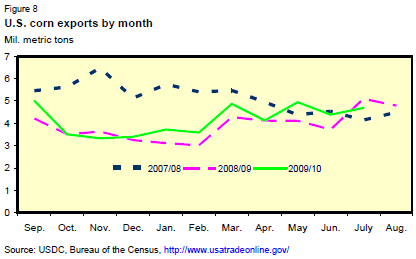
Further Reading
| - | You can view the full report by clicking here. |
September 2010


